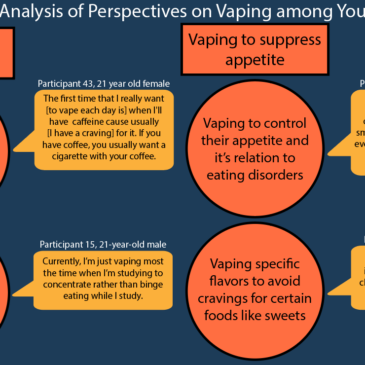Although rates of cigarette smoking have dropped in recent years, these gains are largely offset by increases in teen vaping. This trend calls into question whether certain motives for cigarette smoking carry over to vaping. One common motive for smoking is weight control, thanks in part to aggressive advertising of cigarettes as weight loss aids. This week, ASHES reviews a study by Afton Kechter and colleagues that examined young adults’ thoughts and attitudes towards food and weight through the lens of nicotine smoking.
What was the research question?
How do young adults perceive their relationship with food, weight, and vaping?
What did the researchers do?
The researchers recruited a sample of young adults in a California metropolitan area who reported vaping weekly for at least the past five months. A total of 62 participants completed an hour-long semi-structured interview. Using a qualitative approach, the researchers identified any time participants referenced food or similar ideas like diets and appetite and reviewed these statements to identify themes.
What did they find?
Two main themes emerged from the interviews: vaping during routine activities and vaping to suppress appetite (see Figure, for description of themes and sample quotes). The first theme centers around the normality of vaping during day-to-day activities. Participants pointed to pairing nicotine with their morning caffeine (coffee/energy drinks) and after meals. Others pointed to using vaping to avoid binge eating and help with concentration while studying akin to how some chew gum. Regarding vaping for appetite suppression, participants pointed to vaping to lose weight, though this often came with cyclical patterns of vaping and binge eating. Some participants even spoke about how their vaping for appetite suppression related to eating disorders. Others ran into issues with too little of an appetite because of their vaping.
Figure. Thematic analysis of perspectives on vaping among young adults. Click image to enlarge.
Why do these findings matter?
These findings are important for two reasons. First, they suggest that many of the same rituals and practices youth cigarette users engage in are shared by youth vapers. Further research is needed, then, to clarify whether interventions designed for cigarette users can be used for vape cessation as well. These findings also point to a relationship between vaping, eating disorders, and poor weight management. While some participants were explicit regarding their eating disorders, others appear to have unhealthy cyclical relationships with their weight and vaping. Clinicians working with clients on either smoking cessation or eating disorders should screen for, and address, potential comorbidities.
Every study has limitations. What are the limitations in this study?
Participants in this study were not exclusively e-cigarette users, as half of the participants were dual e-cigarette and combustible cigarette users. It is possible that many of the themes that were similar to cigarette use are due to these dual-user participants. The interview also did not directly inquire about the intersection of food and vaping, but rather these topics came up organically. Because of this, another researcher using a more structured interview process may generate different themes.
For more information:
Young adults who want to learn more about the risks of vaping can learn more at Know the Risks. Others who are ready to quit vaping can find guidance at Smokefree. Individuals experiencing disordered eating may find support at NEDA. Additional resources can be found on our Addiction Resources page.
— John Slabczynski
What do you think? Please use the comment link below to provide feedback on this article.





